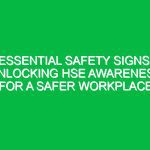Introduction
Hello team! Today, we’re here for our toolbox talk to discuss an essential aspect of our daily operations: COVID-19 Social Distancing. As we navigate through the ongoing challenges posed by the pandemic, it’s crucial that we all understand and implement effective social distancing measures to ensure our Safety and the Safety of our coworkers. This talk will cover practical tips, guidelines, and the importance of maintaining social distance in our workplace, especially within the context of Health, Safety, and Environment (HSE).
Understanding COVID-19 Social Distancing
COVID-19 Social Distancing refers to the practice of maintaining physical space between individuals to reduce the spread of the virus. The primary goal is to minimize close contact, which can facilitate the transmission of the virus. In our work environment, this means keeping a safe distance, typically recommended at least six feet apart, from others whenever possible.
Why is Social Distancing Important?
Maintaining social distance is not just a guideline; it is a critical safety measure that protects us all. Here’s why it matters:
- Reduces Transmission: The main mode of COVID-19 transmission is respiratory droplets produced when an infected person coughs, sneezes, talks, or breathes. Keeping distance helps prevent these droplets from reaching others.
- Protects Vulnerable Individuals: Many of our coworkers may have underlying health conditions that put them at greater risk. Social distancing helps protect everyone.
- Compliance with Regulations: Adhering to social distancing guidelines is often mandated by local health authorities, and compliance is a legal obligation for us as a workforce.
Key Aspects of COVID-19 Social Distancing in HSE
In the context of HSE, understanding the practical implementation of COVID-19 Social Distancing is essential. Here are some key aspects:
1. Workplace Layout
Evaluate your workspace layout. Is there adequate space between workstations? Consider rearranging desks, workstations, and common areas to ensure a minimum distance of six feet. This might involve:
- Using barriers or partitions between desks.
- Designating specific entry and exit points to reduce crowding.
- Implementing staggered shifts to limit the number of people on-site at any given time.
2. Meetings and Gatherings
Gatherings can be a significant risk for virus transmission. Here’s how to handle meetings safely:
- Opt for virtual meetings whenever possible.
- If in-person meetings are necessary, ensure they are held in well-ventilated areas and limit the number of participants.
- Maintain a distance of at least six feet between attendees.
3. Break Times
Breaks are crucial for our well-being, but they can also be a time of increased risk. Implement the following practices:
- Stagger break times to reduce the number of people in break rooms.
- Encourage outdoor breaks where social distancing can be easily maintained.
- Provide clear guidelines for using shared spaces, such as kitchens or lounges.
4. Signage and Communication
Clear communication is vital. Use signage to remind everyone of the importance of social distancing. Place signs in common areas, break rooms, and near entrances. Signs should include:
- Visual reminders to maintain distance.
- Instructions on how to navigate the workspace safely.
Real-Life Scenarios
Let’s consider some real-life scenarios to illustrate the importance of COVID-19 Social Distancing:
Scenario 1: Morning Briefing
Imagine it’s a busy Monday morning, and everyone gathers in the conference room for a briefing. Instead of having everyone crammed together, we can utilize a larger space or even conduct the meeting outdoors. This way, everyone can hear the updates while maintaining a safe distance.
Scenario 2: Equipment Sharing
If your job requires sharing tools or equipment, it’s crucial to establish a protocol. After each use, the equipment should be sanitized, and users should maintain distance while waiting to use shared items.
Best Practices for COVID-19 Social Distancing
To effectively implement COVID-19 Social Distancing, here are some Best Practices to keep in mind:
- Stay Informed: Regularly check updates from health authorities regarding guidelines and recommendations.
- Practice Personal Responsibility: Each of us must take responsibility for our actions. This includes wearing masks when necessary and using hand sanitizer frequently.
- Encourage Open Communication: If you see someone not adhering to social distancing guidelines, kindly remind them of the importance of this practice.
Potential Hazards and Risks
While implementing COVID-19 Social Distancing, it’s essential to be aware of potential Hazards:
- Increased Noise Levels: With fewer people in close quarters, noise levels may rise in open spaces. Be mindful of this as it can lead to communication issues.
- Isolation Effects: Prolonged distancing can lead to feelings of isolation. Encourage team bonding through virtual check-ins or team-building activities that can be done safely.
Regulations and Standards
Let’s talk about regulations. Many local and national authorities have set specific guidelines regarding social distancing. Understanding and complying with these regulations is not only essential for our safety but also for legal obligations under Occupational Health and safety laws.
- Familiarize yourself with your local health authority’s recommendations.
- Ensure that our workplace policies align with these regulations.
- Stay updated as guidelines may change based on the evolving situation.
Conclusion
As we wrap up today’s toolbox talk, let’s remember that practicing COVID-19 Social Distancing is a shared responsibility. Each of us plays a vital role in maintaining a safe working environment. By adhering to these guidelines, we not only protect ourselves but also our families, friends, and colleagues.
Thank you all for your attention and commitment to safety. Let’s keep the conversation going. Do you have any questions, concerns, or suggestions on how we can improve our social distancing measures? Your input is valuable as we strive to create a safer workplace for everyone.


